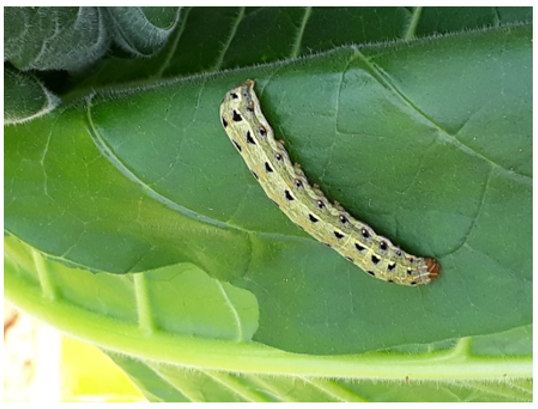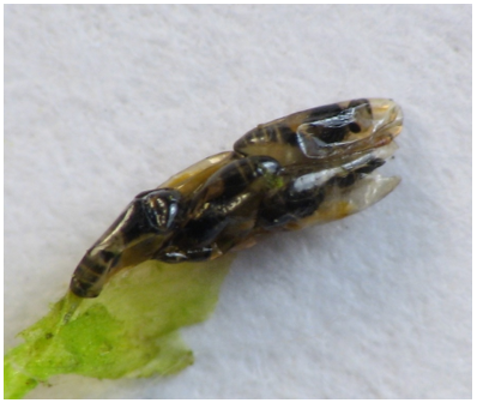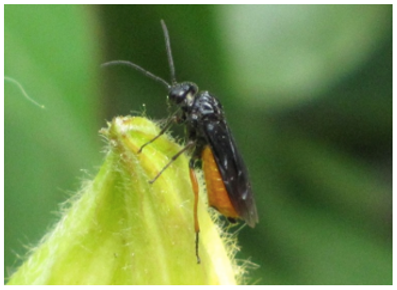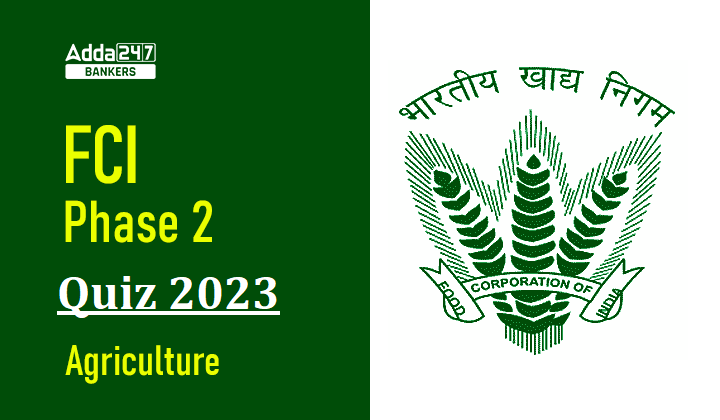Q1. Tanymecus indicus attack which one of the following crop?
(a) Maize
(b) Wheat
(c) Sorghum
(d) Jowar
Q2. Pyrilla perpusila belongs to _______ insect family.
(a) Lophopidae
(b) Pyralidae
(c) Miridae
(d) Noctuidae
Q3. Black tinge along anterior margin of pronotum and black submarginal band on the crown of head caused due to ________________
(a) Male green leaf hopper
(b) Female green leaf hopper
(c) Female stem borer
(d) Male stem borer
Q4. Drying of central shoot or production of profuse side tillers in sorghum plants are damage symptoms of _____________?
(a) Shoot fly
(b) Stem borer
(c) Pink stem borer
(d) Shoot bug
Q5. Site of Pupation of Spodoptera sp. Is_________________
(a) Soil
(b) Under leaf surface
(c) Stem
(d) Leaf sheath
Q6. Family of Leaf blister mite is ____________.
(a) Tenupalpidae
(b) Eriophidae
(c) Tetranychidae
(d) Tarsonemeidae
Q7. Which of the following pest attack in Storage and field condition?
(a) Sitophilus oryzae
(b) Trogoderma granarium
(c) Callosobruchus maculatus
(d) Corcyra caphalonica
Q8. Which one of the following us Most destructive polyphagous pest among the following?
(a) Pink stem borer
(b) Locust
(c) Pod borer
(d) All of these
Q9. Which one of the following is Monophagous parasitoid of rice?
(a) Cotesia
(b) Trichogramma sp.
(c) Platygaster oryzae
(d) Xanthopimpla sp.
Q10. Pupal diapause occurs in which one of the following?
(a) Athalia lugens
(b) Lipaphis erysimi
(c) Spilosoma oblique
(d) Chromatomyia horticola
Solutions
S1. Ans (b)
Sol. Ghujhia Weevil; Tanymecus indicus (Curculionidae: Coleoptera) is a sporadic pest of considerable importance in wheat growing areas. The host range lies in germinating rabi crops viz. Wheat, barley, gram and mustard. Only adults feed on leaves and tender shoots of the host plants. They cut the germinating seedlings at the ground level. Often the crop is resown. The damage is particularly serious during October-November when the rabi crops are germinating. Ghujhia weevil can be managed by dusting carbaryl or malathion 5 D @ 25 kg per ha.
S2. Ans (a)
Sol. Pyrilla perpusilla, commonly known as the sugarcane planthopper, is a planthopper in the family Lophopidae. It is native to Asia where it feeds on grasses and other plants and is a major pest of sugarcane and sorghum.
S3. Ans (a)
Sol. Male green leaf hopper (N. nigropictus) has two black spots extending to black distal portion of forewing, a black tinge along the anterior margin of pronotum and a submarginal black band on the crown of the head.There are about 6 overlapping generations from March to November. The insect overwinters in the adult stage. The pest population is the maximum in July – August and decreases markedly after a heavy rain.
S4. Ans (a)
Sol. The Sorghum shoot fly damage crop at the seedling stage (5 to 30 days after seedling emergence) and will lead to the typical dead heart symptoms. The larva migrates to the upper side of the leaf, and moves along the leaf whorl until it reaches the growing point where the larvae cut the growing point. As a result, the central leaf dries up forming a dead heart, which can be pulled out easily and produces a rotting smell. Parasitoid such as Trichogrammatoidea simmonalsi, Trichogramma chilonis, Neotrichoporoides nyemitawus and predators viz., Spiders, Coccinellids, lace wings etc. are natural enemy of sorghum shoot fly
S5. Ans (a)
Sol. Spodoptera litura, also known as the tobacco cutworm or cotton leafworm, is a nocturnal moth in the family Noctuidae. S. litura is a serious polyphagous pest in Asia, Oceania, and the Indian subcontinent that was first described by Johan Christian Fabricius in 1775. Pupation lasts around 7 to 10 days and takes place on the soil, by forming earthen cocoons near the base of the plant. The pupa is typically 15–20 mm long, and its color is red-brown. A characteristic feature is the presence of two small spines at the tip of the abdomen that are about 0.5 mm long each.

S6. Ans (b)
Sol. Leaf blister mites belong to the family of eriophyoid mites and they can have significant economic meaning in fruit production. These are not free-living organisms and the majority of life they spend sheltered in blisters or under the bud scales, where they overwinter. In spring overwintered females leave the swelling buds and start to feed. In result of their feeding appear small blistered galls inside which females lay eggs. When the trees are numerously infested by leaf blister mites both efficiency of photosynthesis and vigor are significantly reduced
S7. Ans (c)
Sol. Cowpea bruchids (Callosobruchus spp. are the most common and widespread insect pests in storage. Adults are 2 to 3.5 mm long. They are major pests of pulses (cowpeas, pigeon peas, soybean, green gram and lentils). They attack both pods in the field and seeds in storage.
S8. Ans (d)
Sol. Polyphagous pests are those which feed on plants belonging to diverse taxonomic groups. Generally, these pests multiply in large number are voracious feeders and cause considerable damage to agricultural crops. The most important polyphagous pests are termites, grasshoppers, hairy caterpillars, cutworms, etc. Other polyphagous pests include aphids, whiteflies, white grubs, mealy-bugs, tobacco caterpillar, gram caterpillar, etc.
S9. Ans (c)
Sol. Platygaster oryzae, monophagous pest of rice is suitable for the control of Gall midge (Orseolia oryzae). Release of Platygaster oryzae parasitised galls at 1/10 m2 on 10 days after transplanting (DAT).

S10. Ans (a)
Sol. Mustard Sawfly: Athalia lugens (Tenthredinidae: Hymenoptera) have dark green larvae have 8 pairs of abdominal prolegs. There are five black stripes on the back, and the body has a wrinkled appearance. A full-grown larva measures 16-18 mm in ¬length. The adults are small orange yellow insects with black markings on the body and have smoky wings with black veins. The mustard sawfly breeds from October to March and undergoes pupal diapause during summer. The adults emerge from these cocoons early in October. They live for 2-8 days and lay 30-35 eggs singly, in slits made with saw like ovipositors along the underside of the leaf margins. Egg period is 4-8 days and the larvae feed exposed in groups of 3-6 on the leaves during morning and evening. They remain hidden during the day time and, when disturbed, fall to the ground and feign death. There are 7 instars with a larval period of 16-35 days. Pupation is in water proof oval cocoons in soil and the pupal period is 11-31 clays. Life-cycle is completed in 31-34 days. It completes 2-3 generations from October to March.




 GA Capsule for SBI Clerk Mains 2025, Dow...
GA Capsule for SBI Clerk Mains 2025, Dow...
 The Hindu Review October 2022: Download ...
The Hindu Review October 2022: Download ...
 SBI CBO Admit Card 2025 Out at sbi.co.in...
SBI CBO Admit Card 2025 Out at sbi.co.in...


